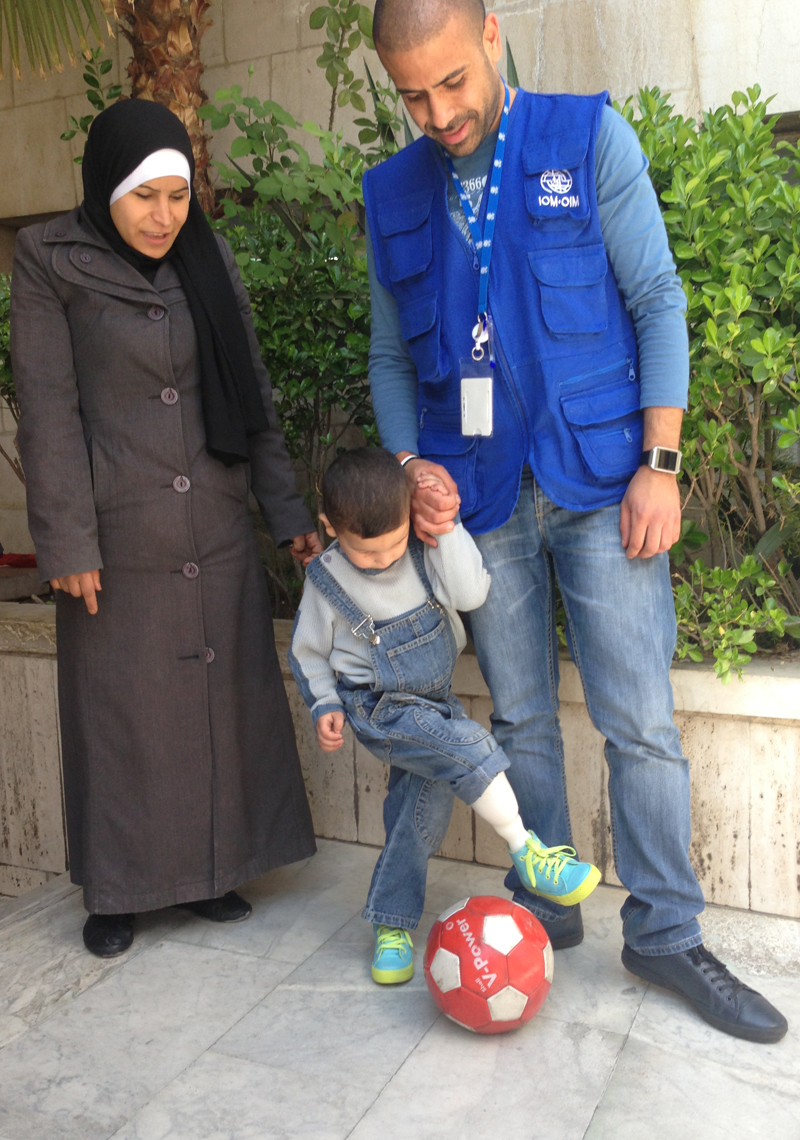 By Kathy Marks
By Kathy Marks
A teenager literally danced with joy. A 12-year-old shouted excitedly as she climbed upstairs unaided. And a soccer-mad boy declared: “Now I can be the Messi of Syria!”
All three had lost limbs as a result of the civil war. Thanks to a programme launched by IOM’s Damascus mission, they had just received an artificial leg – and were rediscovering how to run and play, just like before they were injured.
The $60,000 project – which has already assisted 65 amputees including 12 children – is the result of a partnership between IOM and a Swiss social enterprise, SwissLeg. The latter manufactures lightweight, low-cost prostheses which, unlike most artificial limbs, can be fitted in a few hours and require no rehabilitation.
For Syrian children, a new leg not only transforms their lives – it can save them. It means they can run from danger in a country where a gun battle or mortar attack can erupt at any time.
A UNICEF report last March found that Syria is one of the most dangerous places in the world for children. At least 10,000 are estimated to have been killed since the civil war began more than three years ago. And, according to the International Committee for the Red Cross, children account for many of the half million people injured.
Basem Stass, IOM’s health coordinator in Damascus, says: “This is a war which is taking place not on the battlefield, but in the villages and the cities, in residential neighbourhoods. Civilians are being targeted in their houses and schools, in their mosques, churches and markets, and children are extremely vulnerable.”
Not surprisingly, government agencies and aid organisations have focused on meeting basic requirements such as food and shelter. But that has left people with disabilities marginalised, according to Serin Hetou, IOM Damascus’s national project development officer.
The flexible limbs, which can be adjusted as children grow, were designed by SwissLeg’s chief technical officer, Mohammad Ismail. He has set up a manufacturing centre in Irbid, just over the Syrian-Jordanian border, and has been flying back and forth, taking measurements, making casts and returning to fit the prostheses.
There were emotional scenes when the children – who came from all over Syria, travelling for up to 12 hours – received their new legs. “Imagine, a child arrives in a wheelchair, and by the end of the day he walks out on his feet,” marvels Dr Stass. “They touch their new leg, stretch it out, show it off,” says Ms Hetou. “And you should see their parents’ faces.”
Five-year-old Ahmed was injured in a car accident in 2012 while fleeing violence in his town outside Damascus. With his right leg amputated, he had to give up playing football. After he was fitted with an artificial limb, IOM staff produced a ball. Ms Hetou recalls: “He stood up and started kicking the ball, and his smile went from ear to ear.”
Qassim, aged 10, also lost his right leg. He stopped attending school, and could no longer ride his bicycle: one of his favourite hobbies. Now he is back at school, where he has joined the football team – and hopes to emulate Argentina’s Lionel Messi.
Six-year-old Nour, from Aleppo, was caught in crossfire at a checkpoint. He was so delighted with his new leg that he ran around the room. And then there was 17-year-old Mejid, who “just started dancing … He was actually spinning on his prosthesis,” says Dr Stass. “Then he told us: ‘I’m running home!’ and he leapt up and off he went.”
Among those helped by the project, which was financed by the Kuwaiti Fund, are seven double amputees. They will receive a second prosthesis later on.
They include 12-year-old Salam, who after being fitted with a new leg “started walking with crutches, and insisted on going upstairs”, relates Dr Stass. “And then you should have seen it, she was shouting out that she’s actually going upstairs, imagine that! Simply climbing the stairs was something quite extraordinary for her.”
IOM Damascus wants to expand the programme to assist up to 700 Syrians a year. “There’s a huge need on the ground,” says Dr Stass. Mr Ismail is equally passionate. As well as supplying and fitting the limbs, he has trained an IOM doctor and a physiotherapist in Aleppo in the casting, manfacturing and fitting process.
While affordable prostheses are usually prefabricated and poor quality, those produced by SwissLeg – which is also working with IOM in Iraq – “give recipients exactly the same mobility as with their own legs”, says Mr Ismail.